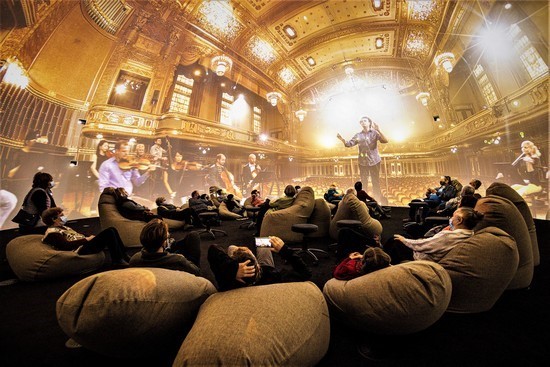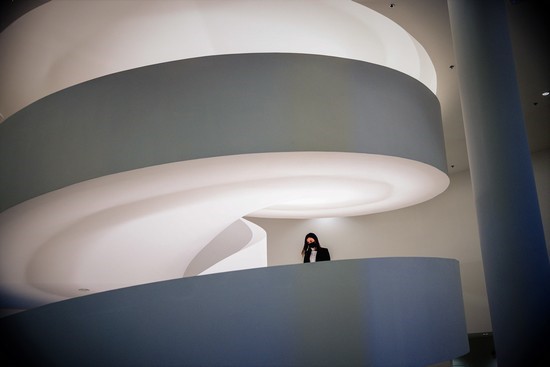BUDAPEST — A polarizing project by the
government of
Viktor Orban, Hungary’s far-right prime minister, to transform
the historic City Park here into a museum district has produced its first
building: the House of Music, Hungary.
اضافة اعلان
Designed by Japanese architect
Sou Fujimoto, the
cultural center, which opened January 23, offers exhibitions, education, and
concerts. An interactive permanent show guides visitors through the historical
development of
Western music; celebrates the contribution of Hungarian
composers such as Liszt, Bartok, and Kodaly; and traces Hungary’s folk music
tradition to its Central Asian roots. One room, painted in the colors of the
Hungarian flag, features video displays on the country’s political history and
famous athletes, with the national anthem as a soundtrack.
 Visitors in the “sound dome,” a 360-degree film and music experience, at the House of Music, Hungary. (Photo: NYTimes)
Visitors in the “sound dome,” a 360-degree film and music experience, at the House of Music, Hungary. (Photo: NYTimes)
Yet beyond the House of Music’s glass walls, which
are animated by reflections of construction elsewhere in the park, this new
building is mired in controversy.
Critics have said that the government’s plans to
develop the 200-year-old City Park into a museum district disturbs the natural
environment, deprives locals of much-needed public space, and raises concerns
about corruption. But those behind the project say that the site has always
been more than a public park and that the undertaking is Europe’s largest urban
development project. In a speech, Orban described the transformation as an “unfinished
work of art.”
In 2012, Orban’s government announced an ambitious
plan to transform the park, in disrepair after decades of neglect, into a
district of five museums. The estimated cost at the time was about $250
million, but that had ballooned to nearly five times the original projections
by 2017.
There had been a virtual consensus that the park
needed work, but the government and park conservationists disagreed about the
fate of the park’s natural features.
A special legal designation allowed the project to
skirt existing development rules, meaning the municipality of Budapest had
little say over the government’s plans. And legislation adopted by Orban’s
party placed the park under the purview of a newly created, state-owned company
controlled by his allies. Sandor Lederer of K-Monitor, an anti-corruption
watchdog, said public records indicate the House of Music alone had cost
Hungarian taxpayers as much as $100 million.
 (Photo: NYTimes)
(Photo: NYTimes)
“The project is a good example of how public
investments work under Orban,” Lederer said. “There are no real needs and
impact assessments done; citizens and affected parties are excluded from
consultations and planning.”
He said poor planning and corruption have benefited
companies widely seen as Orban’s clientele, saying, “Not only present, but also
future generations, will pay the costs of another Orban pet project.”
Laszlo Baan, the government commissioner overseeing
the project, declined to be interviewed, but a spokesperson said in a statement
that the government had so far spent 250 billion Hungarian forints, about $800
million, on the project. Fujimoto’s office did not respond to an interview
request.
In 2016, private security guards clashed with park
conservationists at the future site of the House of Music.
Gergely Karacsony,
an opposition politician who was elected mayor of Budapest in 2019, did not
attend the House of Music’s January 22 unveiling, which took place on the Day
of Hungarian Culture, a national celebration. The building, he wrote on social
media, was born not of culture but of violence.
 (Photo: NYTimes)
(Photo: NYTimes)
In a radio interview, Karacsony recently likened
construction in a public park to urinating in a stoup of holy water: “You can
do it, but it ruins why we are all there.”
Orban, however, has sought to frame the museum
district as a legacy project, and he has used it as a cudgel in his own war
against what he sees as the West’s cultural decline. Unveiling the House of
Music, he attacked critics of the park’s transformation as leftists who opposed
beauty.
“The Hungarian nation never forgets the names of
those who built the country,” Orban said in a speech at the ceremony, adding
that detractors are not remembered, “because the Hungarian nation simply casts
them out of its memory.”
He added that national elections in April would be
“a period” that would end debate over the future of the park.
Since returning to power in 2010, Orban and his
allies have taken over public media, as well as most of the country’s private
media, to promulgate far-right conspiracy theories, attack the regime’s critics
and advance Orban’s culture war, which has also reached academia and the arts.
Hungary’s cities are currently blanketed in political ads featuring Orban’s
main political opponent as Mini-Me from the Austin Powers movies.
Orban’s political machine interprets culture as
“something that must be occupied or conquered,” said Krisztian Nyary, an author
who grew up near City Park. “They are only capable of thinking in terms of
political logic, but culture is different.”
He added: “Do we need a House of Music? I don’t
know. I see it’s a beautiful building, and I’m sure they’ll have exciting
events, but it doesn’t belong there.” Repurposing the park transforms its
function, he said, jeopardizing a valuable natural environment that has served
as “the lungs” of surrounding neighborhoods.
The park is bordered by the Sixth and Seventh
districts, which Gabor Kerpel-Fronius, Budapest’s deputy mayor, said have the
fewest green spaces in the city. The museum district, he added, could have been
planned elsewhere, such as in a rundown rust zone nearby.
Imre Kormendy, an architect, served as president of
the Hungarian Society for Urban Planning when the museum district project
began. He quickly learned that the government had no intention of meaningful
consultation with stakeholders, he said.
“Naive professionals such as myself had no idea this
project had already been decided,” he said. “Not even the Guggenheim was
constructed inside of Central Park. Why should a city park be burdened with
such development?”
Yet Eszter Reisz, who raised her family in the area,
said the park’s development was “fantastic” in comparison with its previously
unkempt condition.
For Klara Garay, a 71-year-old biology teacher who
has lived near the park for decades, the repurposing of the park epitomizes the
general climate in Hungary. She has been protesting against the park’s
redevelopment since it began.
“I feel despair,” she said. “This country is morally
at such a low point.”
Although the House of Music aims for
community-building and education, the strife over its genesis is a reminder of
why many of Hungary’s most celebrated musicians — such as Bartok and Gyorgy
Ligeti — left the country.
“The political past of Hungary has been very
problematic in certain phases of its history,” said musicologist Felix Meyer,
who runs the Paul Sacher Foundation in
Switzerland. Many of the country’s
talented musicians, he added, chose to live in the West.
“It’s as simple as that,” Meyer said. “Hungary was a
small country and could be very repressive, and not all of them felt
appreciated. These are great minds, very liberal minds, people who needed space
and opportunities, so it’s natural they made big careers outside of Hungary.”
Acclaimed Hungarian pianist Andras Schiff, who has
been in self-imposed exile for more than a decade in protest of Orban’s
politics, said by phone that “the way Orban supports culture is very
selective.” Schiff added that Orban “will support everything that follows him,
everybody who joins the bandwagon.”
Orban’s government, Schiff said, tried “very hard to
change history and change the facts, but it would be better to work on that, to
admit faults and mistakes.”
Asked if he would consider returning to Hungary if
Orban were ousted in April, Schiff said, “Yes, certainly.”
“I would love to come back,” he said. “This is the place I
was born, it’s my mother tongue, and I deeply love Hungarian culture.”
Read more Culture and Arts



